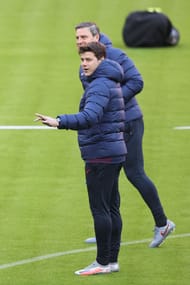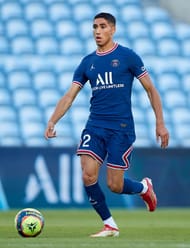When Nasser Al-Khelaifi sat on his smug throne of riches next to Lionel Messi, his audience had barely grappled with the reality unfolding before them. The Paris Saint-Germain president had his shiniest new toy, the one he longed lustfully for from a distance, for even he knew that his deepest of desires bordered on sin.
One wonders whether or not even he was surprised with the ease of it all. The embodiment of the purest of footballing joys that Messi is, was now signing for a team other than that of his boyhood, dashing in one brutal swipe of his signature the ailing romanticism of the beautiful game.
This is not to lay the blame at Messi's wondrous feet - it is hardly his fault that FC Barcelona imploded the way it did, and it is perhaps better for the sake of the sport that Messi gets to line up next to the galaxy of stars at PSG than the bloated misfits of the blaugrana.
Now what?
Such an innocuous line of query is but natural when the improbable is accomplished with swashbuckling ease. The hard work is seemingly done, the impossibility of the task at hand reduced to an inevitability. The mountain has been climbed and conquered, and now with the arduous ascent behind, one can embark on the breezy descent.
It has often proved a slippery slope.
The chaos in the Catalan club manifested itself as catharsis in Paris. The unlikeliest of transfers took place right before our unbelieving eyes, with Messi now teaming up with former footballing flame Neymar and the heir to his poster-boy crown, Kylian Mbappe. One can sit for hours and debate the righteousness of the move - in desperate attempts to cling onto a moral high ground in the process - but one cannot dispute that on paper, this could be the most fearsome attacking trio ever assembled in the history of the sport.
But that’s the thing: the money has been splashed and the unlikeliest of forces assembled, in what has been a remarkable week in football.
So, now what?

Pochettino needs to harness the Messi magic
The responsibility of realizing the unprecedented potency of PSG’s attackers falls on the shoulders of Messi’s compatriot, Mauricio Pochettino. He is highly regarded in world football, undoubtedly, but this is, by some distance, his sternest test. At Espanyol, he punched above his weight on a shoestring budget. Coherency and stability were introduced at Southampton. Exciting was how one could characterize his energetic exploits at Tottenham Hotspur, almost catapulting him to legendary status in North London.
But he did all that away from the glare of the world shining bright on his visage. Now, he has no escape. Global attention is now on Paris, and should Pochettino stumble even slightly, one can expect gasps of disbelief and a healthy dose of schadenfreude. How does he navigate that, and a dressing room of undoubted ability but also of simmering egos?
If we are to arrive at the drawing board, away from the humdrum of newfound Parisian Messi-mania, perhaps we would spot Pochettino plotting a back three, in a 3-4-3 formation, wherein he can afford to unleash his attacking threesome of Messi, Neymar and Mbappe, and yet maintain a semblance of structure.
Marquinhos, Presnel Kimpembe and another new arrival in Sergio Ramos complete the back three, with Juan Bernat and Achraf Hakimi out wide occupying the wing back berths.
The 3-4-3 derives its inherent balance from the addition of another center-back, and also from the fact that it can offer passing options to the wingbacks at all areas of the pitch - their starting positions are in the middle, and while defending they drop back to make a back 5.
In joining the attack, they stretch opposition defences and allow the front three to roam freely and stay nearer the goal. The responsibility of offering breadth, therefore, in all likelihood will not fall on Messi, Neymar or Mbappe.
Neither would the responsibility for the press. In all likelihood, at least two of the three would retain their high positions even without the ball - probably with Messi dropping slightly deeper, which will then allow PSG to utilize his immaculate range of passing, as he tries to find Neymar and Mbappe on the break.
Lesser numbers in the press imply that the midfielders need to cover more ground - and in Gini Wijnaldum, PSG have in their ranks a modern prototype who can do just that. Alongside either Italian dynamo Marco Verratti - fresh from his starring role in the Azzuri’s victory at Euro 2020 - or the Argentine Leandro Paredes, Wijnaldum could be tasked with cutting off passing lanes in behind and staying narrow.
Covering the half spaces behind the wing-backs could also be the midfield duo’s responsibility, when Hakimi and Bernat go out to meet opposition wide players - this allows the back three to stay in shape, and mitigates the risk of smart movement in these half spaces pulling them out of shape.

The biggest advantage of the 3-4-3 is how it allows for the manipulation of the wide areas - and in Achraf Hakimi, PSG have also signed the finest proponent of the art of wing play. One can imagine PSG’s front three attracting significant attention from opposition markers. Neymar and Mbappe in particular need space to operate in - by being narrow, teams could often force PSG to look one-dimensional. Manchester City did it to perfection in their Champions League semifinal second leg, shutting down the central areas, knowing that PSG had no personnel to take advantage from out wide.
It is arguably Hakimi who makes PSG a more complete team than any of his fellow new arrivals - perhaps even including Messi (let’s be real, did PSG actually need him?). The Moroccan international can alleviate this problem and allow the inside forwards to shine by hugging the touchlines on the right. If Pochettino feels adventurous, he could even attempt deploying the perpetually handy Angel Di Maria as a left wing back, against teams that sit deep - which, one presumes, is most teams against the Parisians - in order to carry out the same orders on the other flank.
With the added spaces opened up in a stretched defence - generally comprising four players - the havoc Mbappe, Neymar and Messi can wreak is unfathomable, not necessarily in terms of just goals, but the very interplay between them can be joyous to witness, almost offsetting the peculiarity of seeing Messi in another shade of blue and red.

A 4-3-3 is also on the table, one imagines, for Pochettino. It isn’t fundamentally different from the 3-4-3 but would see a defender drop out for a midfielder. Paredes, Wijnaldum and Veratti could all start, with Hakimi and Bernat in full-back positions. While Hakimi bombs forward, Bernat could hold his position and effectively transform PSG’s shape into a lopsided 3-2-5, a la Italy of the Euros this summer, with Wijnaldum doing the ‘Barella’ role of making late, unmarked runs into the box. He has done that aplomb for the Dutch national team too.
This does not compromise on the balance a starting 3-4-3 offers, and also allows the likes of Veratti and Wijnaldum to pick up where they left off at the Euros. A back four also allows an additional defender to collect passes from the goalkeeper, and offers another passing option, which could allow PSG to build from the back, retaining possession if up against lower blocks, or being able to play through the press, if facing against teams with higher starting positions.
Most importantly, a back three in any shape or form - whether starting or in-play - requires great levels of understanding. France found out to their dismay at the Euros that just switching to a back three when players aren’t comfortable with the system could have disastrous consequences. PSG’s advantage to that end is that in positions of crucial structural importance, they have players who are comfortable with the system - Hakimi, Verratti, Wijnaldum, Paredes, and arguably even Di Maria, whose versatility does not get the credit it warrants.
PSG have pulled off a coup nobody could ever have imagined. The ink is yet to dry on Messi’s signature but the world’s eyes are trained on the French capital. For all the hype, however, a front three is only as good as the rest of the team, and the playing XI is only as good as the system it is deployed in. How Pochettino deploys his fellow Argentine, and how the team is built with him could be crucial to PSG’s attempts at attaining the absolute, unquestionable domination they so crave.
